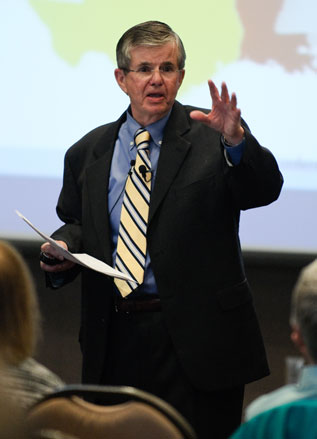Northern Arizona University President John Haeger challenged faculty and staff to redesign undergraduate education at NAU to improve student performance and address needs of the 21st century.
The president backed up his challenge with a $1 million incentive—creating an Innovation Fund for individuals or departments who can write new curricula or redesign current curricula that eliminate impediments to student progress.
Speaking to about 200 people during a campus-wide forum at the High Country Conference Center, Haeger called for a reimagining of standard—and perhaps outdated—principles that guide decision-making at a university level.
“There are policies that hinder students’ pathways to a degree,” he said. “It doesn’t make a whole lot of academic sense.”
He specifically cited three issues that result in students lingering too long toward their degrees: too many prerequisites prior to entering some majors, students’ retaking courses to earn better grades, and allowing students to drop courses 12 weeks into the semester.
He also suggested that freshmen should have full loads and should be directed toward majors faster.
The president questioned whether the health of a university’s curriculum should be determined by a higher number of degrees and course options and whether all instruction should be delivered by tenured faculty. “Do we need a hundred-some programs?” he asked.
“I told you at the beginning of my talk that I may raise more questions than answers,” he told the crowd. “I’m talking about the need to rethink campus as a whole.”
The goal of addressing higher education’s performance issues is to increase NAU’s retention rate, which hovers around 70 percent, and increase the number of “high quality” baccalaureates, which is deemed necessary for Arizona to remain economically competitive.
He cautioned, however, that some degrees needed for the future are not being offered by NAU today. “We need new programs explicitly tied to the 21st century needs—green jobs, health informatics, service management, health professions and sustainability,” he said. “We need to invest in growing programs. The question is on the table: Do we need to redirect funds from low-demand programs?”
Resources also must be dedicated to the university’s Extended Campuses model, which brings lower-cost, highly structured degree programs to students across the state. The “new reality,” he said, is a mission differentiation between the Flagstaff campus—with its combination of research and teaching—and the branch and community campuses, which are teaching focused.
Haeger said that any university changes must be conducted within the constraints of Arizona’s budget crisis, which has resulted in Northern Arizona University operating on an ever-shrinking budget despite record enrollment growth.
“There are clear warning signs that the budget is not going to return,” he said. “We need to figure out how to make the institution sustainable.” At the same time, he warned against continued increases in tuition. “There is some level at which tuition can’t get any higher.”
One step toward reallocating resources involves the possibility of offering retirement incentives to tenured faculty 62 and older. Details of the any retirement incentive will be issued within a few weeks.
Additionally, the president introduced his plan for an Innovation Fund that would encourage staff and faculty across campus to offer real plans to increase the university’s efficiency and smooth the pathway for degree completion. Details of the Innovation Fund, which will use one-time federal stimulus dollars, will be forthcoming, but Haeger indicated that he is encouraging all faculty and staff to submit plans for consideration.
The president’s complete presentation will be available soon at http://extended.nau.edu/tvs/president/.



